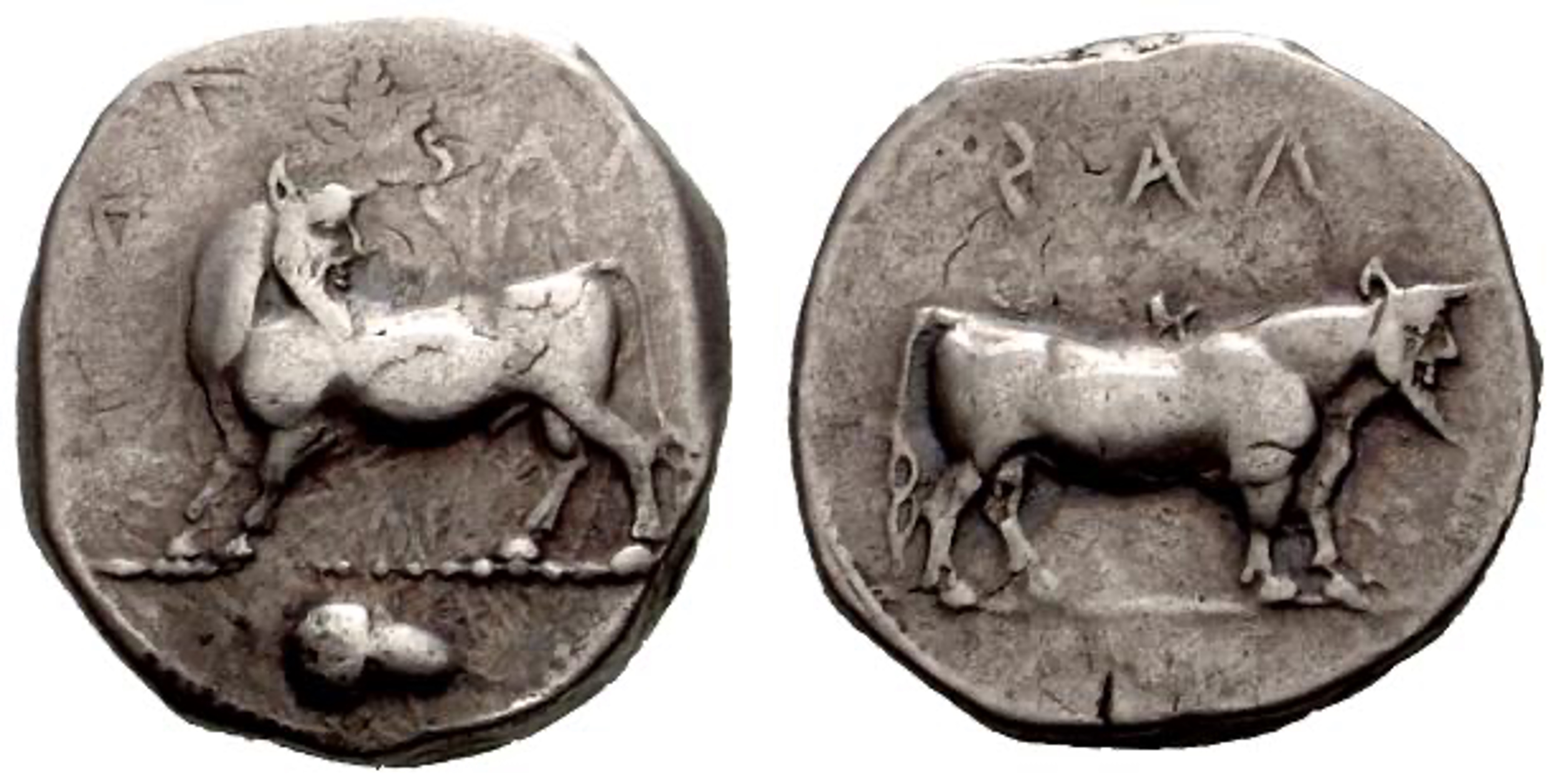2101 - Laüs (nomos man-faced bull/man-faced bull) over Caulonia (Poseidon/stag) (NAC, 29, May 2005, 32): Difference between revisions
From SILVER
No edit summary |
No edit summary |
||
| Line 17: | Line 17: | ||
|Denomination=tridrachm / nomos | |Denomination=tridrachm / nomos | ||
|Standard=Achaian (Hoover) | |Standard=Achaian (Hoover) | ||
|Coin series reference=SNG Fitzwilliam I, n° 446 (these dies) | |Coin series reference=SNG Fitzwilliam I, n° 446 (these dies) ; HN Italy, n° 2277 (these dies) ; HGC 1, n° 1537 | ||
|Overstruck mint=Caulonia | |Overstruck mint=Caulonia | ||
|Overstruck ancient region=Magna Graecia (Bruttium) | |Overstruck ancient region=Magna Graecia (Bruttium) | ||
}} | }} | ||
Revision as of 14:28, 5 June 2023
480 BCE - 460 BCEΛAS | ΛAS
Location/history
| Sale(s)Sale(s) ᵖ: | NAC 29 (11/05/2005), lot 32. | |
Overstriking coin
Description
| ObverseInscription or printing placed on the obverse.: | ΛAS (Greek) Man-headed bull left, head reverted. In exergue, acorn. | ReverseInscription or printing placed on the reverse.: | ΛAS (Greek) Man headed bull (Acheloo) right. |
Mint and issuing power
| MintIdentifies the place of manufacture or issue of a numismatic object.: | Laüs | Ancient regionAncient region. | Magna Graecia (Lucania) | Modern countryModern country: Italy | AuthorityIdentifies the issuing power. The authority can be "pretended" when the name or the portrait of X is on the coin but he/she was not the issuing power. It can also be "uncertain" when there is no mention of X on the coin but he/she was the issuing power according to the historical sources: |
Chronology
| FromIdentifies the initial date in a range assigned in a numismatic context. 480 BCE toIdentifies the final date in a range assigned in a numismatic context.. 460 BCE | Classical 480-323 BC |
Physical description
| MetalThe physical material (usually metal) from which an object is made.: Silver |
WeightWeight of the numismatic object (in grams). in grams: 7.977.97 g <br />7,970 mg <br /> | DenominationTerm indicating the value of a numismatic object. Examples: tetradrachm, chalkous, denarius.: tridrachm / nomos | |
| StandardStandard.: Achaian (Hoover) | |||
References
| Coin referenceReference of the Coin: | Coin series referenceReference to coin series study: | SNG Fitzwilliam I1SNG Fitzwilliam I, n° 446 (these dies), HN Italy2HN Italy, n° 2277 (these dies), HGC 13HGC 1, n° 1537 |
Overstruck type
Description
| ObverseInscription or printing placed on the obverse.: | ReverseInscription or printing placed on the reverse.: |
Mint and issuing power
| MintIdentifies the place of manufacture or issue of a numismatic object. ᵖ: | Caulonia | Ancient regionAncient region. ᵖ | Magna Graecia (Bruttium) | Modern countryModern country: Italy | AuthorityIdentifies the authority in whose name (explicitly or implicitly) a numismatic object was issued. ᵖ: |
Chronology
| FromIdentifies the initial date in a range assigned in a numismatic context. toIdentifies the final date in a range assigned in a numismatic context.. | periodTime period of the numismatic object. |
Physical description
References
| Coin type referenceReference to coin series study ᵖ: |
Additional data
| Frequency of overstrikesFrequency of overstrikes: | Level of confidenceLevel of confidence of the identification: | ||
| RemarksRemarks: | |||
References
- ^ Clarke, Louis C. G. (1940), Sylloge Nummorum Graecorum. Great Britain. Vol. 4 : Fitzwilliam Museum : Leake and general collections. Part 1, Spain (Emporiae, Rhoda)-Italy, London, Oxford University Press.
- ^ Rutter N. Keith et alii (eds.) (2001), Historia Numorum Italy, London, xvi, 223 p., 43 pl.
- ^ Hoover, Oliver D. (2018), The Handbook of Greek Coinage Series, Volume 1. Handbook of Coins of Italy and Magna Graecia, Sixth to First Centuries BC., Lancaster-London, 2018, lxi, 527 pages, 23 cm
